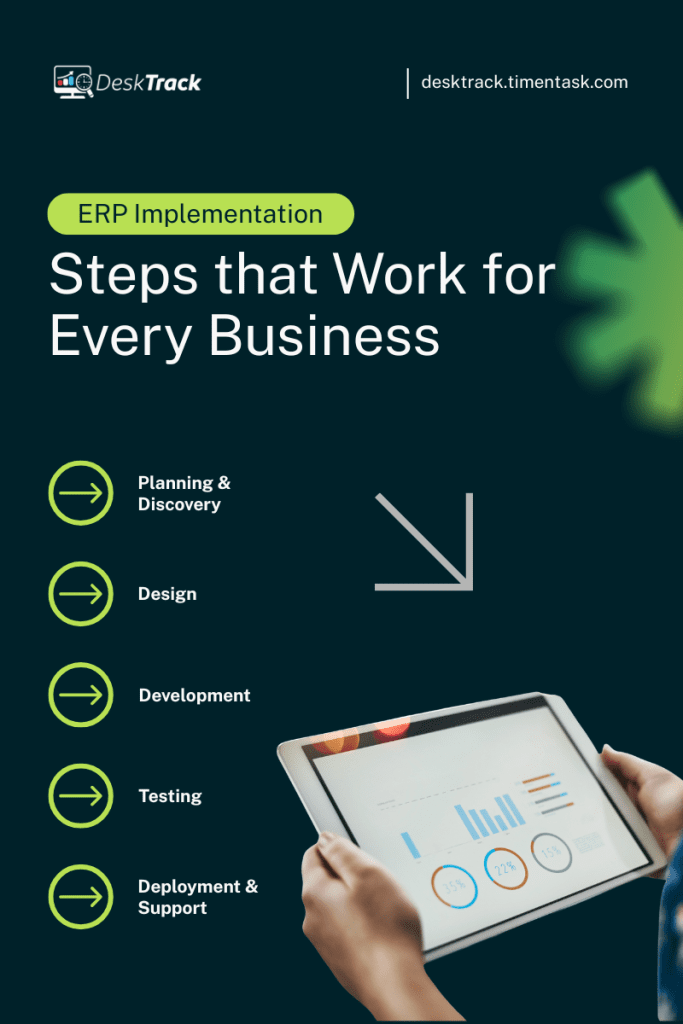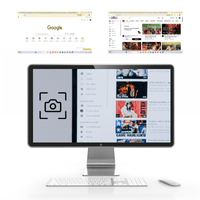
Sure, each division in your organization has unique plus points, and even the work itself is varied. However, only when they interconnect will you achieve success. When departments are spread out, it’s challenging or even impossible to reach the right resource quickly during times of urgency. Plus, there is also a lack of strong collaboration, and sharing important updates breaks the workflow as well. So, what you require is a robust and scalable ERP system.
What is an ERP System?

In short, an enterprise resource planning system literally unscatters all your departments. You can think of it like a master database in layman’s terms, which makes information access possible anywhere and at any time. Presently, modern ERP systems will:
- Automate manual tasks
- Join all internal business data.
- Get your Fortune 500 configured for success in the new normal.
Read Also: All You Need to Know About Job Rotation in Businesses
ERP Implementation Steps that Work for Every Business

As hard as it may sound, enterprise resource planning implementation is pretty simple. All you need is careful planning and just a little bit of effort from your technical teams to get every step of the ERP process correct.
1. Planning & Discovery
Firstly, make a careful plan for the best ERP software that you come across. We would research in detail to pinpoint exactly what we need first. After that, the next phases involve scheduling the days for implementation, collecting resources, preparing your HR, and other obvious things.
2. Design
Now you need to bring the implementation to fruition. Firstly, you need to design what your ERP will look like. We recommend reviewing and editing this a lot before finalizing. It’s always wise to include your HR and stakeholders in this step to get useful input and ensure that there is no confusion.
3. Development
You will obviously code your enterprise resource planning software. That’s where your development teams come in. Especially if the new system you want to transition to involves advanced technical aspects for implementation.
4. Testing
Directly deploying the new system during your ERP implementation plan is a grave mistake. That’s because if there is any issue that you might have missed, it will be expensive and time-consuming to fix and downright embarrassing as well. So, before rolling out the complete change, it’s a wise idea to test the enterprise planning software at a lower stage.
5. Deployment & Support
Once you are sure that everything is in place, the next part is to involve all the contributors, schedule dates, and slowly make the switch to EP automation. Plus, it’s also a good idea to keep providing continuous real-time help to everyone using it for optimized working.
Key Enterprise Resource Planning Implementation Strategies for Effectiveness
There are numerous methods that you can use for enterprise resource planning implementation:
- Big Bang: What you are doing is establishing everything together. Although this method provides the advantage of not having to deal with parallel operations, any issue in the process can majorly impact your entire organization. Also, this way, it can be overwhelming for the people involved.
- Phased Rollout: This approach is also obvious. In short, implement ERP in stages across your departments, user groups, and teams. It’s a calculated method that lets you solve issues, one phase at a time, for a smoother transition to a new system.
- Pilot: This one is very close to simulating a new system. So, what you do is introduce the system on a small scale first. This allows you to prevent big risks, collect feedback, and solve issues before the full-scale launch.
- Hybrid: This works in the situation where none of the default strategies work for the project. For successful enterprise resource planning implementation for this work, we strongly suggest combining elements from the above 3 strategies to meet the requirements of your project. Yes, that’s all there is to it.
Best Enterprise Resource Planning Implementation Practices
Along with the proven strategies, our experts also recommend using the best practices to implement ERP for maximum effectiveness and benefits.
- Get Ready for Establishing: Adapting to a new scheme without blueprinting will outcome in chaos. That’s because your workers will not be ready for the variation due to being used to the old system.
- Don’t Underestimate Training & Support: Providing training and support to your employees is also essential to ensure that they are able to comfortably adapt to the new system. Especially your non-tech people.
- Carefully Plan Data Migration: When implementing a new system, don’t forget to migrate all crucial data to the cloud. We recommend having a data backup just in case there are some issues.
- Communicate & Collaborate: To ensure stability in the implementation process, it’s also a good habit to communicate the schedule to all the people involved, such as your clients. It’s even better if you collaborate with everyone involved to provide immediate help till the implementation is complete.
- Build a Strong Project Team: As we mentioned before, developing a strong, technically sound, and specifically skilled project team is also crucial for successfully switching to your new enterprise resource planning software.
- Select a Scalable ERP System: Your enterprise will surely branch out. So must be your new ERP system. Whether you get add-ons or memory expansions, there must be some kind of scalability and flexibility in the tools.
- Monitor Post Implementation: After implementing your new system for enterprise resource planning, it’s also essential to monitor how it’s working, whether your employees are comfortable with it, if it’s benefiting you at all, and other obvious things to identify and eliminate any issues.
Benefits of ERP System Implementation for Your Business
Here are a few benefits of implementing an enterprise resource planning system and software. These may be just 3. However, they provide you with a major advantage.
- Real-Time Actionable Insights: Having the right enterprise resource planning software and system in place centralizes all your data for anywhere and anytime access. This unscattered data helps you monitor the health of your business in a streamlined way.
- Better Operational Efficiency: The emphasis here is on automation. Remember, as a modern business owner, you need this to save time, decrease effort, reduce expenses, and skyrocket profitability.
- Simplified Deployment, Use & Maintenance: Implementing the right ERP process, system, and software. Especially on the cloud makes it scalable, automatic, and provides anywhere access for information and insights. This is more useful for businesses scattered across the globe.
Read Also: Top 10 Document Management Software for Your Business in 2025
The Risks of Not Implementing an ERP System
To further elaborate on the importance of ERP, let’s get straight to what you will face if you don’t implement this system in your organization.
- Inability to identify and eliminate problems affecting sales
- No visibility into your evolving sales deals and pipeline
- Challenging to expand sales due to the lack of ability to capture upselling chances
- You end up executing misaligned marketing campaigns, lacking concrete leads, which result in disconnected sales hand-offs
- You can’t evaluate fluctuating performance data, making it impossible to spot chances or predict customer requirements
- The lack of connections with the required systems for launching new services and products
- No technology for supporting international operations and consumers
- You will have no choice but to code extensively to connect to third-party software and hardware
What’s Next?
We can conclude that ERP implementation is necessary and very advantageous for your business. ERP expands to enterprise resource planning, where enterprise and planning depend on your part. However, the resources include your human resources as well. So, just like you monitor everything else in your organization, monitoring employees has also become the new norm. With DeskTrack’s all-in-one workforce and work management software, you get real-time project management, time tracking, employee monitoring, and productivity monitoring features on a single user-friendly platform. Plus, it’s more scalable than your ERP system. Try now and realize how businesses across 100+ countries benefit from using the tool.
Frequently Asked Questions (FAQ)
Q. What Do You Mean by ERP?
Ans. In short, an enterprise resource planning system literally unscatters all your departments. You can think of it like a master database in layman’s terms, which makes information access possible anywhere and at any time. Presently, modern ERP systems will automate manual tasks, collectivize all inventory, product, manufacturing, distribution, and project-related information, and prepare your business for success in the digital economy.
Q. Is ERP a SAP system?
Ans. Yes. SAP is actually an organization that develops and provides enterprise resource planning software solutions for commercial use.
Q. What is ERP vs CRM?
Ans. ERP involves only the processes and departments central to your business, such as internal business operations, including finance, inventory, and HR. On the other hand, CRM focuses on consumer-centric activities like sales, marketing, and services.
Q. Why is the ERP Project Team Important?
Ans. Like everything else, the project teams in enterprise resource planning implementation also play a central part. These teams have to be strong, skilled, and must have the time and support for successful implementation.
Q. What are the Risks of Not Implementing an ERP System?
Ans. To further elaborate on the importance of ERP, let’s get straight to what you will face if you don’t implement this system in your organization.
- Inability to identify and eliminate problems affecting sales
- No visibility into your evolving sales deals and pipeline
- Challenging to expand sales due to the lack of ability to capture upselling chances
- You end up executing misaligned marketing campaigns, lacking concrete leads, which result in disconnected sales hand-offs
- You can’t evaluate fluctuating performance data, making it impossible to spot chances or predict customer requirements
- The lack of connections with the required systems for launching new services and products
- No technology for supporting international operations and consumers
- You will have no choice but to code extensively to connect to third-party software and hardware










